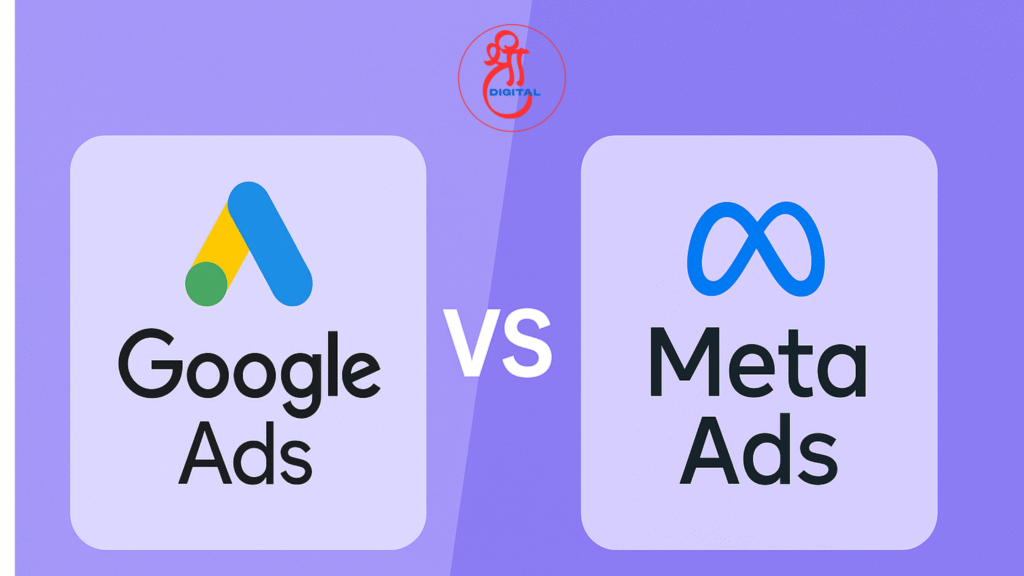
Google Ads vs Meta Ads: Which One Is Best for Your Brand?
In today’s hyper-competitive digital world, Google Ads vs Meta Ads has become the battleground for brands seeking visibility, traffic, and conversions. Two giants dominate the landscape: Google Ads and Meta Ads (formerly Facebook Ads). Each offers unique advantages, targeting capabilities, and ad formats—but which one is best for your brand?
Let’s break down the pros, cons, and strategic use cases of each to help you make an informed decision.
Need help choosing or managing your ad platforms? Partner with Shri Digital to craft a custom strategy that delivers real results.
Understanding the Platforms
Google Ads
Google Ads is a search intent-driven advertising platform. When someone types a query into Google (or uses YouTube, Google Maps, or partner sites), Google serves ads relevant to that query.
Best For: Capturing demand, high-intent traffic, local searches, and quick conversions.
Ad Types: Search Ads, Display Ads, Shopping Ads, YouTube Video Ads, App Promotion.
Meta Ads
Meta Ads operates across Facebook, Instagram, Messenger, and the Meta Audience Network. It’s a discovery-based platform, meaning users are shown ads based on interests, behaviors, and demographics—not active search queries.
Best For: Building brand awareness, creating communities, storytelling, and engaging visual campaigns.
Ad Types: Image, Video, Carousel, Stories, Reels, Lead Forms, Messenger Ads.
Comparing Key Features
1. Audience Targeting
Google Ads: Leverages keyword intent. You target users searching for specific terms. Google also offers Custom Audiences, In-Market Audiences, and Remarketing based on behavior.
Meta Ads: Offers advanced audience targeting using demographics, interests, behaviors, lookalike audiences, and pixel-based retargeting. It’s particularly strong for top-of-funnel marketing.
👉 Winner: Meta Ads for broader audience building. Google Ads for intent-driven targeting.
2. Cost & ROI
Google Ads: Typically has higher CPCs (Cost Per Click), especially for competitive industries like finance, legal, or eCommerce. However, it often delivers higher conversion intent.
Meta Ads: Generally lower CPCs, but users might not be ready to buy. It may take multiple touchpoints to convert.
👉 Winner: Depends on goals. Google Ads wins for direct conversions. Meta Ads excels for brand building at a lower cost.
3. Ad Formats & Creative
Google Ads: Less visual, more text-based (except for YouTube and Display). Works best with strong copywriting and compelling calls to action.
Meta Ads: Highly visual and interactive. Great for product showcases, videos, reels, and storytelling.
👉 Winner: Meta Ads—if your brand thrives on visuals and engagement.
4. User Intent
Google Ads: Targets users who are actively searching with purchase intent (e.g., “best running shoes for men”).
Meta Ads: Interrupts users while they’re browsing socially, relying more on persuasion and curiosity.
👉 Winner: Google Ads for bottom-of-funnel, Meta Ads for top- and mid-funnel.
5. Analytics & Optimization
Google Ads: Offers powerful metrics through Google Analytics, Search Console, and Data Studio. Granular keyword-level data.
Meta Ads: Provides robust pixel data, audience insights, and event tracking. Great for A/B testing creative variations.
👉 Winner: Google Ads for precision data. Meta Ads for creative performance insights.
So…Which One Should You Choose?
The best platform depends on your business goals, audience, budget, and sales funnel stage.
✅ Choose Google Ads if:
You need immediate conversions.
Your product/service has high search demand.
You’re in a competitive niche and want to target intent-heavy users.
You’re promoting local services or eCommerce products.
✅ Choose Meta Ads if:
You’re building brand awareness.
You want to run engaging, visual campaigns.
You have a longer sales cycle and want to nurture leads.
Your product is impulse-driven or emotionally appealing (e.g., fashion, travel, lifestyle).
A Smart Strategy? Use Both Together.
Many successful brands don’t choose between Google and Meta—they integrate both in a full-funnel strategy:
Use Meta Ads to drive awareness and engagement with videos and carousel ads.
Retarget Meta audiences with special offers or lead magnets.
Use Google Ads to capture those who now search your brand or product name.
Retarget via Google Display Ads or YouTube for additional touchpoints.
This dual-channel approach boosts visibility, improves trust, and nurtures users through the funnel.
Final Verdict
There’s no one-size-fits-all answer. Google Ads vs Meta Ads both offer unique strengths. The key is understanding your audience’s behavior, mapping your customer journey, and choosing the right mix of intent vs. discovery advertising.
Test. Analyze. Optimize. Your ideal platform in the Google Ads vs Meta Ads debate may not be the one with the biggest budget—but the one that delivers the most value per click.
